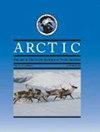楚科奇半岛近岸水域环斑海豹(Phoca hispida)的观察
IF 0.8
4区 地球科学
Q4 ENVIRONMENTAL SCIENCES
引用次数: 0
摘要
尽管环斑海豹在楚科奇自治区的区域经济中占有重要地位,但随着商业渔业的结束,俄罗斯对环斑海豹的研究几乎完全停止了。在土著人捕猎海豹的楚科奇半岛沿岸地区,很少有人对其进行研究。本文研究了楚科奇沿岸环斑海豹(Phoca hispida)的现代分布和栖息地。1993 - 1996年、1998 - 2000年、2002 - 2005年和2010 - 2011年在楚科奇半岛海岸的哨所对环斑海豹和其他海洋哺乳动物进行了同步观测。野外研究提供了环斑海豹在海岸带的空间和季节分布、运动和相对丰度的信息。冬季,在阿纳德尔湾北部南部沿海地区的浮冰上,以及楚科奇半岛东部海湾的浮冰及其边缘上,都发现了海豹的身影。春季,环斑海豹主要聚集在塞亚文海峡、拉夫连提亚湾和特克琴湾的快冰上。人们注意到幼海豹向楚科奇海的迁徙。夏季动物主要分布在整个楚科奇半岛的海岸带,但相对数量减少了85%。深秋时,海豹主要聚集在拉夫伦蒂亚湾、塞尼亚文海峡和特克琴湾的幼冰上。楚科奇半岛东岸的陆冰是白令海环斑海豹繁殖的主要区域之一。本文章由计算机程序翻译,如有差异,请以英文原文为准。
Observations of Ringed Seal (Phoca hispida) in the Nearshore Waters of the Chukotka Peninsula
Despite the importance of ringed seals in the regional economy of the Chukotka Autonomous District, with the end of the commercial fishery, research on the ringed seal in Russia has almost completely ceased. The coastal zone of the Chukotka Peninsula, where the Native people hunt for seals, has seen very little research. This paper is devoted to the study of the modern distribution and habitat of the ringed seal (Phoca hispida) in the coastal waters of Chukotka. Observations of ringed seals were carried out simultaneously with observations of other species of marine mammals from posts located on the coast of the Chukotka Peninsula in 1993 – 96, 1998 – 2000, 2002 – 05, and 2010 – 11. Field studies provided information on the spatial and seasonal distribution, movements, and relative abundance of the ringed seal in the coastal zone. In winter, seals were found on the drifting ice in the southern coastal area of the northern part of the Gulf of Anadyr, and on fast ice and its edge in the bays of the eastern part of the Chukotka Peninsula. In spring, the main aggregations of ringed seals were observed on fast ice in Senyavin Strait, Lavrentiya Bay, and Tkachen Bay. The migration of immature seals to the Chukchi Sea was noted. In summer, animals were distributed in the coastal zone of the entire Chukotka Peninsula, but their relative number decreased by 85%. In late autumn, the main aggregations of seals were observed on the young ice of Lavrentiya Bay, in Senyavin Strait, and in Tkachen Bay. The landfast ice of the eastern coastal zone of Chukotka Peninsula is one of the main areas for the reproduction of ringed seals in the Bering Sea.
求助全文
通过发布文献求助,成功后即可免费获取论文全文。
去求助
来源期刊

Arctic
地学-环境科学
CiteScore
2.30
自引率
0.00%
发文量
51
审稿时长
6-12 weeks
期刊介绍:
Arctic is a peer-reviewed, primary research journal that publishes the results of scientific research
from all areas of Arctic scholarship. Original scholarly papers in the physical, social, and biological
sciences, humanities, engineering, and technology are included, as are book reviews,
commentaries, letters to the editor, and profiles of significant people, places, or events of northern
interest
 求助内容:
求助内容: 应助结果提醒方式:
应助结果提醒方式:


